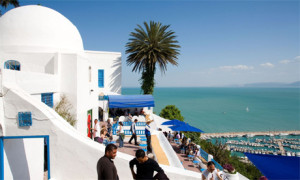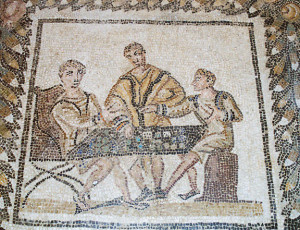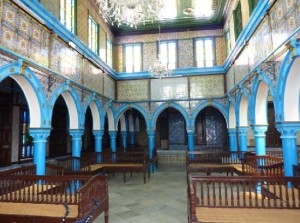
Sidi Bou Said, near Tunis, is one of Tunisia’s premier — and most colorful — resort towns . Photo from TourismTunisia.com.
When my son sang in a children’s choir some years ago, I attended a meeting where parents were debating whether it was safe to send their kids off to Britain to compete in the famous National Eisteddfod competition in Wales.
There had been some recent bombings and kidnappings in London, the first stop on their itinerary — hence the concern. I noted that the choir members would have more to fear from the bus ride from the airport into the city than from any sightseeing or other activities they would experience in London or Wales.
My statement was immediately misinterpreted by a number of other parents who thought I was suggesting that terrorists would be out to kidnap or bomb a busload of choir boys and girls just in from America. What I meant to say is that, statistically (and realistically) speaking, there was a far greater chance the bus would be involved in a traffic accident than face terrorist threats.
Now, with civil unrest ticking up in the Middle East, the Ukraine and elsewhere, nearly half of Americans says they’re more concerned about traveling than in the past, according to a survey by the US Travel Insurance Association. (Interestingly, the same survey showed that those of baby boomer age were less likely to change their plans than younger travelers.)
The recent shootings at the Bardo Museum in Tunis, Tunisia, though, have me concerned about the future of tourism in that country, especially since a number of the victims were from cruise ships on a shore excursion.
I don’t mean in any way to downplay the tragedy of their deaths or the vile nature of the attack. It’s both heartbreaking and scary stuff. And I understand if anyone has second thoughts about visiting Tunisia or the Bardo Museum right now.
But it’s also a shame, and causing travelers to stay away from one of the most traditionally stable, secular Arab nations — the birthplace of 2011’s “Arab Spring” — is exactly what a terrorist attack like this sets out to do. If it works, it will be repeated, and we’ll all be the worse for it.
Tourism plays a big role in Tunisia’s economy, and for good reason. The country has a wealth of attractions, wonderful cuisine, and some real surprises in store.
Start with Tunis and its old medina, a maze of narrow, souk-lined streets, and one of the most exotic settings in North Africa. The Bardo Museum, a huge draw, displays some of the finest Roman mosaics in the world.
Near Tunis, you can visit the nearby site of ancient Carthage — of Hannibal and his elephants crossing the Alps fame — and relax, eat, or shop at one of the prettiest seaside towns in the entire Mediterranean, Sidi Bou Said, where almost all the houses are painted blue and white.
Any of these spots can easily be reached on a cruise ship stop. From the docks, you can even ride a commuter train into the heart of Tunis or out to Sidi Bou Said.
South of Tunis, away from the green belt that borders the sea, the vast sands of the Sahara start to open up for travelers who can stay a while to explore. If you’ve never ridden a camel, this is your chance — as I did, quickly coming to the realization that I’m probably not the next Lawrence of Arabia.
Like the first Star Wars series? You can visit the sites where many of the scenes were shot. Remember Tatooine, Luke Skywalker’s desert-like home planet? That was shot in Tataouine, Tunisia.
Stop in or stay at the underground troglodyte cave Hotel Sidi Driss in Matmata, which served as the interior of Luke’s home. If you can snag one of the 20 rooms there, you’ll find it to be one of the most unusual hotel stays of your life.
Unfortunately, tourists have recently been staying away from these fairly remote Star Wars sites, which have attracted ISIS-inspired jihadists en route to Libya, about 60 miles to the east. Since there is some risk involved, may The Force be with you if you go.
A huge surprise came when we approached the town of El Djem in northern Tunisia. There, rising magnificently but almost inexplicably out of this dusty desert town, was what appeared to be an almost exact replica of the Roman Colosseum. But this wasn’t a film set — the huge amphitheater was built by the Romans when their empire stretched to North Africa.
Food-wise, it’s hard to go wrong with Tunisia’s often fiery hot couscous, which may include lamb, sea food, or vegetables laced with a red chili sauce called harissa, or with the long, thin and also spicy merguez sausages. Cool down with juicy oranges and figs for dessert. A former French colony, Tunisia also retains significant influences from France in its cuisine and general culture.
Surrounded by turbulent Libya on one side and once-turbulent Algeria on the other, relatively tiny Tunisia has had to weather rough times before. In 2002, a terrorist bombing of a synagogue on the Tunisian resort island of Djerba — reputed to have been the land of the lotus-eaters from Homer’s Odyssey and another Star Wars film location — set the tourism industry there back several years.
Now tragedy has struck again, this time at the Bardo Museum on a day when cruise ships were in port. But, like many well publicized terrorist attacks, it may well prove to be an isolated incident — and I hope the tragedy isn’t compounded by travelers and cruise lines avoiding this always intriguing and traditionally stable little country.














Leave a Reply